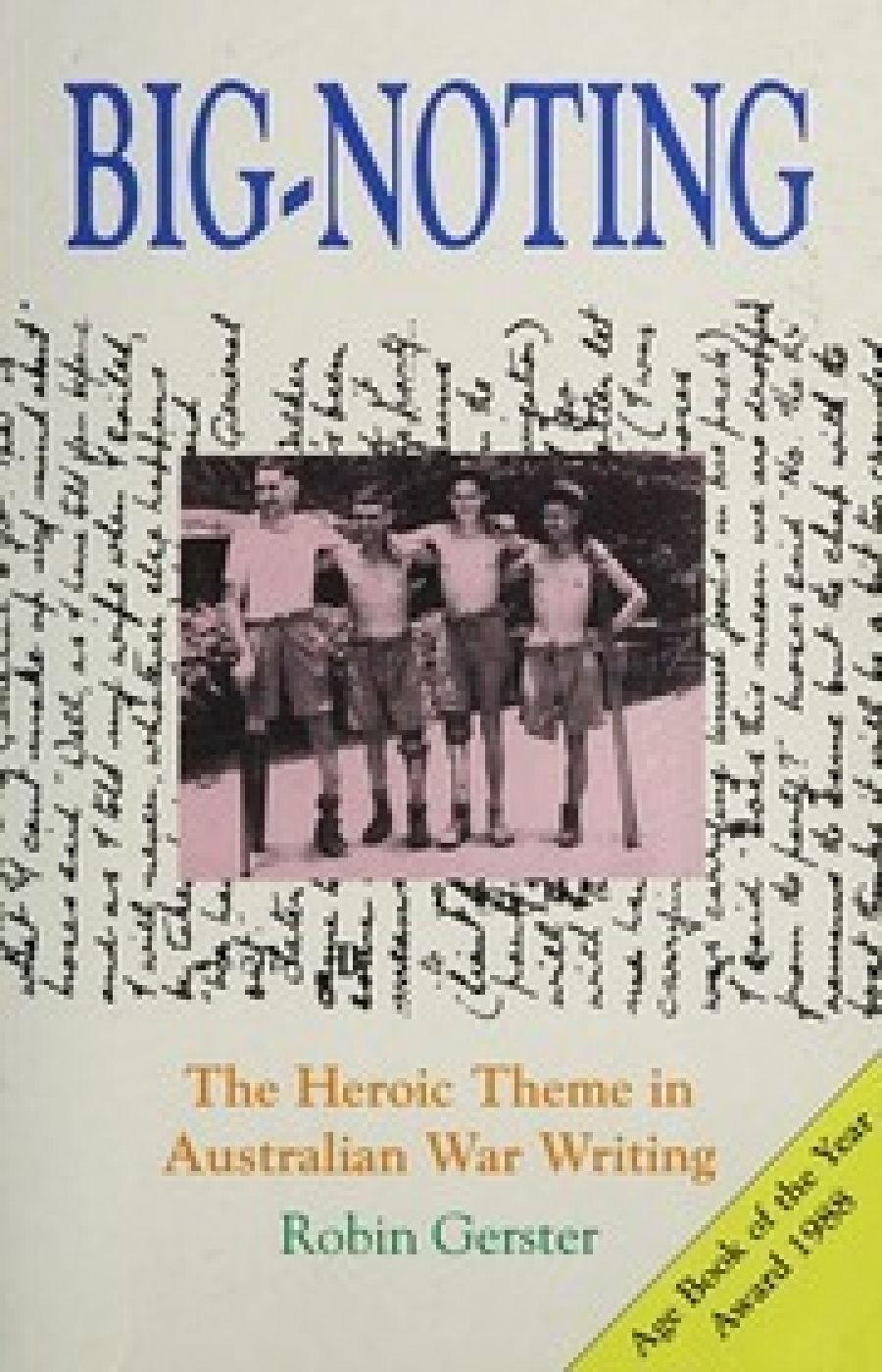
- Free Article: No
- Contents Category: Literary Studies
- Review Article: Yes
- Article Title: Mythology in the making
- Online Only: No
- Custom Highlight Text:
At a time when critics are becoming increasingly interested in Australia’s war literature, Robin Gerster turns to it for an understanding of how national legends are created and perpetuated.
- Book 1 Title: Big-noting
- Book 1 Subtitle: The heroic theme in Australian war writing
- Book 1 Biblio: Melbourne University Press, $34.95 hb, 294 pp
English war writing had behind it the weight of a long literary tradition. In Australia according to Gerster:
without a national tradition of battle literature on which they could draw, the war writers cultivated a fresh, home-grown heroic image, while simultaneously exploiting an imported one from antiquity.
General Monash was one who successfully inspired his men by comparing them to ‘Homeric heroes’. The Greek myths were transplanted to Australian literary soil where the image of the Anzac was born in a glorious recreation of the ‘legendary Trojan battlefield so tantalizingly close to Gallipoli itself’. For the non-combatant Australian, too, there was a personal reflected glory in transposing individual military exploits into literature. It is Gerster’s thesis that:
From 1915 on, every mode of Australian war prose … typically functions either overtly or covertly as a twentieth-century embodiment of classical heroic virtue.
Nevertheless, he does not deny that some war writing was critical of the Australian soldier and of the tendency to elevate him to the status of a ‘superhuman’. But because the Australian people needed it as a means of self-definition the ‘bronzed Anzac’ image prevailed. Indeed, officially any contradictory portrayal was regarded as ‘unAustralian’.
Gerster also stresses the debt of the mythologisers to the bushman of 1890s writing. The same fictional man who conquered the hostilities of the Australian environment, the laconic Patersonian and Lawsonian protagonist, is created anew as the military hero. This war literature extends the 1890s myth of the efficacy of mateship and confirms the ascendancy of masculine values.
The Australian war literature surveyed in Big-noting is impressively wide, ranging from the official histories, notably that of C.E.W. Bean who drew the blueprint for ‘big-noting’ in The Anzac Book (1916), through fiction, personal diaries, newspaper reports, and official documents. The sheer volume of war writing will come as a surprise to readers who are unaware of how pervasive this literature has been in shaping national perceptions. Only the poetry of war seems to have been neglected.
Gerster’s analysis of the POW literature of World War II is of particular interest for his insight into the racial component which governed Australian prisoners’ attitudes towards their captors:
a consuming race-phobia has lingered on in many former prisoners … the Germans were generally regarded as equals or at least as white racial cousins.
But in the case of prisoners of the Japanese ‘submission to the mercy of an enemy held to be racially inferior compounded the bitterness and dishonour. Gerster’s account of this literature is sympathetic and carefully balanced but it is implicit that race-phobia has been widely disseminated through POW writing and that Australians’ perceptions of their Asian neighbours are partially determined by it still.
Gerster’s approach to his material while lively and probing, is traditional in its methodology. John Docker, in a recent review, became confused over what sort of critical tag should be attached to him. He might, perhaps, be a ‘structuralist’, or perhaps not; but probably, after all, he is a ‘Leavisite’. But Docker is missing the point badly when he claims that the book:
values an élite of ‘men of conspicuously sensitive, imaginative and artistic temperament’, of a ‘delicacy of fine feeling’, who stand out against and above the vulgar Australian crowd.
Gerster’s values are much more robust than this. Readers can be reassured that Big-noting is a work of far greater freshness and originality than Docker’s comments imply and one that breaks important new ground in the understanding of Australian culture. Its weaknesses, such as they are, derive principally from its origin in a doctoral thesis. This leads, at times, to an over-accumulation of detail. Those long seduced by the myth will, of course, have their own quarrels. Big-noting is important not because of its author’s place in the critical spectrum but because it opens up new areas for discussion in Australian literature. Perhaps it is time now to recognize the impact that war writing has on a nation’s literature instead of discussing it separately, and often dismissively, as inferior. The literature even of the most professional writers exhibits the influence of a society changed by the circumstances of war. If the responsibility for the creation of a national myth lies with that nation’s artists then, ultimately, says Gerster, art must be the means of re-evaluation, one that may prove more valuable for a people’s self-image in a nuclear age than the anachronistic ‘hero’ figure Australians have needed to revere.


Comments powered by CComment